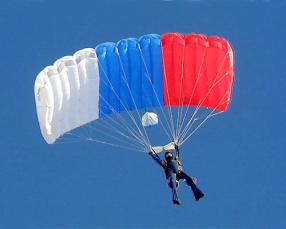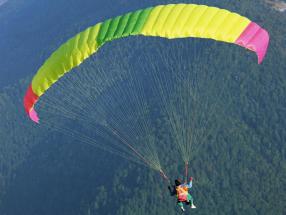U-Turn Physics under the Dome (part 2)
 You should begin training in high-speed landing by approaching in a straight line with acceleration by two front free ends, which must be pulled up by 10-12 cm.This approach will be similar to the standard one, except that the front free ends must be smoothly started to release at a height of several feet ( 1 foot = 0.309 m) above the one on which you usually begin to perform a “pillow”. The “pillow” itself runs smoothly and slowly. If you have to run after landing in calm weather, you have executed the “pillow” too low, or the brakes are set too low on the control lines. This point must be eliminated before you start practicing landing with acceleration on the front free ends. The main thing, before performing any maneuvers with the front free ends, make sure that you hold the brakes securely and that they are firmly fixed to the control lines!
You should begin training in high-speed landing by approaching in a straight line with acceleration by two front free ends, which must be pulled up by 10-12 cm.This approach will be similar to the standard one, except that the front free ends must be smoothly started to release at a height of several feet ( 1 foot = 0.309 m) above the one on which you usually begin to perform a “pillow”. The “pillow” itself runs smoothly and slowly. If you have to run after landing in calm weather, you have executed the “pillow” too low, or the brakes are set too low on the control lines. This point must be eliminated before you start practicing landing with acceleration on the front free ends. The main thing, before performing any maneuvers with the front free ends, make sure that you hold the brakes securely and that they are firmly fixed to the control lines!
When you start practicing this technique, ask an experienced skydiver pilot to look at a few of your landings, and even better – take them on camera and take them apart with you. From the outside, it is easier to see with an experienced eye whether you are working too aggressively with the front free ends, whether you need to move the brakes, whether you introduce brakes symmetrically when performing a “pillow” and so on.
When you achieve that all your landings are carried out without flights and shortages, and you don’t have to urgently change your landing plan due to previously unnoticed domes, you can proceed with a small turn using the front free ends. Be honest with yourself: if you have to justify an unsuccessful approach with “good” reasons like “the wind has changed”, “the student is out of nowhere”, etc., this means that you have not completely mastered the two first steps: control of the air situation and control of the touchdown site. Excuses mean unwillingness to take responsibility for insufficient experience or calculation error. Such a mood has no place in the world of high-speed domes. The high speed of piloting modern domes is a source of great potential danger for participants in the jumps, and places great responsibility on pilots. Took on tug:
Next, go to the shallow turns at the front free ends of 30-45 degrees to the landing line, with the transition to acceleration by two ends until the start of the “pillow”. If you have to sharply enter brakes to exit a turn or acceleration, you have started the maneuver too low. A good landing is performed with the gradual insertion and withdrawal of the front free ends, followed by a smooth, slow “pillow”. Jerking the brake clearly indicates a bad technique. For a good landing, the dome accelerates slowly and moves to the “pillow” almost by itself as the pilot releases the front free ends and gradually introduces brakes to maintain horizontal flight as the dome slows down. Over time, you can increase the angle of rotation on the landing line to 90 degrees and let go of the front free end just before the start point of the “pillow”.
Turns of more than 90 degrees carry an unacceptable degree of risk for other skydivers. Observing the air situation becomes very difficult if you deviate from the generally accepted approach pattern. It is equally important that for other participants in the movement it becomes very difficult to watch you! Passing in the wind over the site and turning 180 degrees not only dramatically change the vertical and horizontal components of speed, but also violate the scheme that others are used to. In addition, a turn of more than 90 degrees does not add significant additional speed, but it significantly increases the likelihood of an error, and not only from the performer of the hook-turn. Among other paratroopers in the air there may be people who do not have enough experience to compensate for getting into a satellite stream. Someone may be frightened and begin a maneuver of evasion from an undisciplined pilot. The same safety rules apply to people on earth. Among random viewers, for example, there may be people with physical disabilities, or just people who do not understand how fast parachutes fly. And few skydivers, after landing, like to hear the whistle of microline lines behind their backs and wonder if they will become another victim.
Speed is our friend, and flying under the dome without acceleration by the front free ends can be compared to driving a car no higher than 2nd speed. But you must always remember that almost all the forces of physics on which our flight depends are proportional to the square of the speed. The energy accumulated during flight means that fast domes are not inclined to forgive mistakes, as slower domes can do. In addition, much faster time is left for calculation and decision making at high speed.




